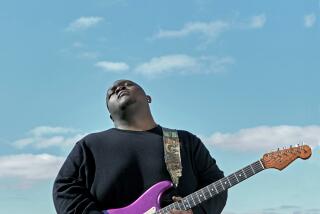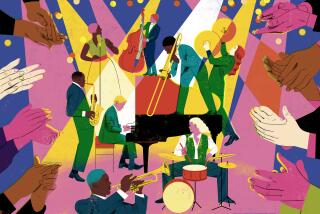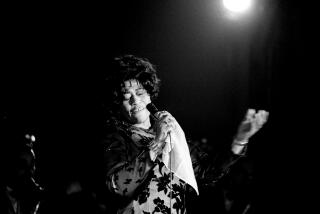Disregarding Trends, Lee Konitz Carries On
Lee Konitz comes on stage looking like a studious, mild-mannered rabbi. White-bearded, introspective, he lifts his alto saxophone and begins to play, the sounds unfolding with a cool, intimate focus. Like the late pianist Bill Evans, his concentration, his urgent desire to reach into the heart of the music, makes every solo an adventurous quest.
Konitz, who starts a six-day run at the Jazz Bakery in Culver City on Tuesday, has been an enigmatic figure in jazz for nearly five decades. At 69, the veteran performer has survived big bands, bebop, rock, fusion and rap, continually following a less-traveled path of his own choosing.
His playing, almost from the beginning, has been masterful, the voice of a genuine original. Regularly recording and performing, he has built up a large and valuable body of work. Yet he has never really received the acclaim that his talent seems to have warranted.
So why is this quiet performer--the antithesis of the jazz man as outgoing entertainer--such a persistently fascinating artist?
For two primary reasons.
The first has been Konitzâs resolute insistence upon taking on the role of jazz outsider, moving beyond the mainstream, especially in the early years of his career, to play in a style that was at significant variance from the then-dominant bebop style. His career has taken full advantage of jazzâs historical respect for individual expression, and he has used the intrinsic liberation provided by his role as outsider to explore a wide range of musical options--a stint in the unlikely setting of the Stan Kenton band, the organization of his own nine-piece ensemble, solo and duet performances, recordings with strings, singers, and almost every imaginable combination of instruments.
His appearance at the Bakery, for example, will find him in the company of pianist Brad Mehldau and bassist Charlie Haden--two strong players with ideas of their own about improvisation, rhythmic grooves and harmonic structure.
Equally important, there will be no drummer, opening the possibility for subtle, multilayered rhythmic interaction between the musicians, with more opportunity for Konitz to stretch his improvisational wings.
Switching gears for his final day at the Bakery next Sunday, he will perform in an entirely different musical setting, with entirely different parameters, when he appears only with guitarist Larry Koonse. (The day after the engagement concludes, Konitz will marry his German fiancee at the club.)
âThis is going to be a relaxed, inspired, and very spontaneous gig,â says Haden, âbecause spontaneity is where Lee comes from, and thatâs where Brad and I come from. In fact, the only program idea that Lee suggested wasnât even specifically musical. He said, âWhy donât we do some tunes associated with dreams--like âWeaver of Dreamsâ and âDream,â things like that.â And then he talked about maybe a tribute to Nat Cole. But thatâs Lee. He just doesnât want to do the things that everybody else does.â
Konitz fascinates for a second reason, as well. And that, to paraphrase Marlon Brando, is because there was a time when he very well âcoulda been a contenda,â a primary influence upon the trends of jazz. Instead, he became an independent voice, an outsider who still managed to attract the attention and admiration of the insiders.
Konitz came on the scene as a true original in the late 1940s, his style already remarkably well-formed, a potentially influential player by the time he was in his early 20s.
There was, however, a problem: Konitz arrived at a time when alto saxophonist Charlie âBirdâ Parker (with Dizzy Gillespie, Thelonious Monk and others) was already inventing a new jazz language--bebop. It was a language, along with a vocabulary and a dialect, that would become so pervasive that it eventually encompassed the jazz world, leaving little room for alternative approaches. Virtually every saxophonist in jazz who came to maturity after the late 1940s was indelibly affected by Parkerâs playing.
But Konitz, seven years younger than Parker, insisted upon making his own musical passage. The decision, at the time, was a courageous one; to not play bebop in the late â40s and early â50s was to be stamped as either a âmoldy figâ or a cold intellectual.
And Konitzâs sound, with its pure-centered quality, similar to the traditional French classical approach to the alto, was often described as âchilly.â His improvisations--unlike the blues-based, harmonically intricate lines of bebop--moved in and around the harmonies, sometimes in near-modal fashion, sometimes in dissonant opposition to the chords. Finally, his music, almost without exception, never made concessions to commercial considerations. He was a true original, determinedly moving against the growing widespread, tidal mainstream of bebop.
Although his method was, for alto players, one of the few viable alternatives to Parker, Konitzâs direct influence upon his contemporaries then and now has been limited.
Even so, thereâs no question that the widely popular Paul Desmond sound and style, despite the softer, more intimate qualities, were deeply affected by Konitz. And the West Coast jazz players of the â50s, strongly impacted by the Davis âBirth of the Coolâ sessions, also revealed traces of the Konitz style in the work of, among others, Art Pepper and Bud Shank. Good as these players were (and are, in Shankâs case), their music never quite reached the level of innovation and achievement so apparent in Konitzâs work.
âWith Lee,â says Haden, âitâs not about technique, itâs about the spirituality of the musical language. He has internalized all the basic technique to the point where itâs become part of his being. His voice, and his direction and the way he hears, are all completely at the service of his creative expression.â
Some recent Konitz recordings reveal how successfully he has followed his wish to explore a personal pathway through a wide range of musical styles. âBrazilian Rhapsodyâ (MusicMasters) finds him performing tunes such as âManha De Carnavalâ and âInsensatezâ with a rich warmth and emotion not always present in his more youthful days, while âRhapsodyâ and âRhapsody IIâ (Evidence) showcase Konitz in a startling array of duo settings.
Two reissues feature his sterling work from the â50s: âLee Konitz Meets Jimmy Giuffreâ (Verve), and âThe Complete Pacific Jazz Recordings of the Gerry Mulligan Quartetâ (Pacific Jazz), which includes nine revelatory tracks from 1953 in which Konitz plays with astonishing originality.
More to Read
The biggest entertainment stories
Get our big stories about Hollywood, film, television, music, arts, culture and more right in your inbox as soon as they publish.
You may occasionally receive promotional content from the Los Angeles Times.










